If you saw the recent “Guess the Focal Length” Twitter post, this is where we reveal the answers. You can of course jump straight to the end, but since the photos were part of a set – all shot on the same day, with the same camera and the same set of lenses – I thought I’d share a few more photos, and also talk a bit about how I came to be cycling through Danish marshland on a cold February day.
Along the way – because this is a photography blog, and because this article germinated from the guessing game – I’ll share some thoughts on the lenses I used, and the creative opportunities and constraints that different focal lengths can offer.
Bedtime story
My earliest marshland memory is from when I was six or seven years old. My dad had just read me an abridged version of Frankenstein, from the Ladybird Horror series for children, as a bedtime story. The monster did not scare me at all; in fact I was sort of rooting for him all along. This made me somewhat smug – I was a smug kid in general – and I said something like, “This is not scary! They call this horror? Let me know when you find something that’s actually scary.” (I’m paraphrasing of course.) That’s when my dad decided, for my next bedtime story, to read me another book from the same series: The Hound of the Baskervilles.
The part I remember most vividly is where Dr. Mortimer recounts finding Sir Charles’ body on the moor. There was no sign of injury, the doctor says, but some little distance off, he observed footprints – fresh and clear.
“Footprints?” asks Holmes.
“Footprints.”
“A man’s or a woman’s?”
Dr. Mortimer’s voice sinks to a whisper. “Mr. Holmes, they were the footprints of a gigantic hound!”
It was getting late, so the first night’s session ended there. But the doctor’s words kept coming back to haunt me in the night. I woke up several times in a cold sweat, and the next morning, I told my mum to hide the book where I would never have to see it again. (I think she gave my dad a piece of her mind.) But eventually I got over my fears and finished the story. And thanks to Conan Doyle’s sinister evocation of the Dartmoor landscape, I’ve been fascinated by marshland ever since.
The setting
I like walking through marshland, reading about it, taking photographs… but what I like best of all, when roads networks allow, is cycling through marshland.
Kalvebod Fælled is a wetland preserve on the outskirts of Copenhagen. I love cycling through it, and I have tried – not always successfully – to capture its mysterious, brooding atmosphere on black-and-white film. Like Dartmoor, the marsh has served as the setting for a famous psychological thriller: in the Scandi-noir TV series The Killing, 19-year-old Nanna Birk Larsen’s body was found in Pinseskoven, a birch forest which features in my photos below.
The gear
On my bike ride I carried my Leica M3 (with a first-generation Summicron 50mm f/2) slung on my shoulder. I had two more lenses in my jacket pockets – a Voigtländer Ultron 28mm f/1.9 and a Leitz Tele-Elmar 135mm f/4 (these being all the rangefinder lenses I own). Cycling is much more fun if I’m not encumbered by heavy gear or a camera bag.
Rangefinders have some drawbacks, but size is not one of them. Here’s my Summicron 50mm f/2 sitting next to my Nikkor 50mm f/1.8 DSLR lens (which, funnily enough, was used to “scan” the photos in this post).
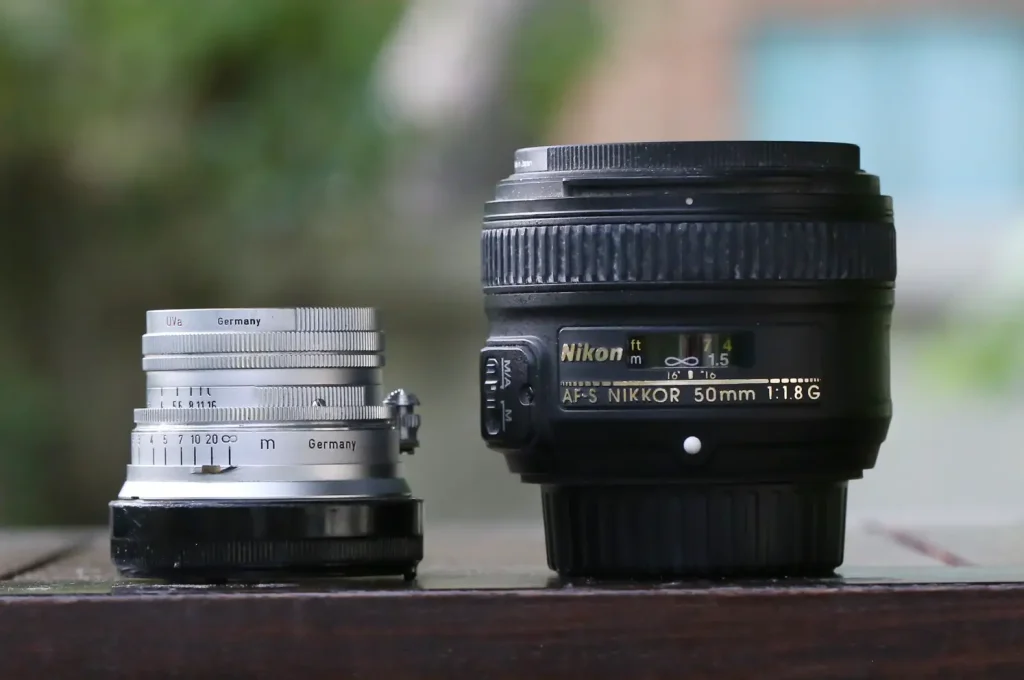
Focal length choice
The idea behind the focal-length guessing game was to have a bit of fun, and also to draw attention to the creative opportunities and distinctive “look” offered by different focal lengths. Experienced photographers are aware of this of course, but in my teens I started out with just one lens (a 50mm prime) and used it for years, without a proper appreciation of what other focal lengths could offer. (Such an approach has its merits, but it’s better to make such choices consciously, not in an uninformed or unthinking way.)
The waters are further muddied by well-meaning but misleading advice like “zoom with your feet”. This is often impractical (try zooming with your feet towards a sunset), and besides, different focal lengths produce characteristic optical effects like perspective distortion/compression. And we haven’t even got to the never-ending Prime vs Zoom debate (short answer: it depends).
By the way, a prime lens, for anyone not familiar with the term, is one with a fixed focal length, as opposed to a zoom lens where you can… zoom. Zooms are often confused with telephoto lenses, but they are not the same. Not all telephoto lenses are zooms (my Tele-Elmar 135mm is a telephoto prime) and not all zoom lenses are telephoto (Nikon’s famous 25-50mm f/4, released in 1979, is a wide-to-normal zoom).
Anyhow, my days of using just a 50mm prime are long behind me; I now have several lenses from ultra-wide to telephoto zoom for film and digital. But for general photography, I personally find the 28–50–135 setup to be a good balance of lightness and versatility.

The photos
Now that you know all about my camera and lenses, allow me to introduce you to the other protagonist: my bike, a companion on many of my photographic forays. It’s unpretentious but versatile – a bit like the 50mm focal length, which is what I used for this photo.
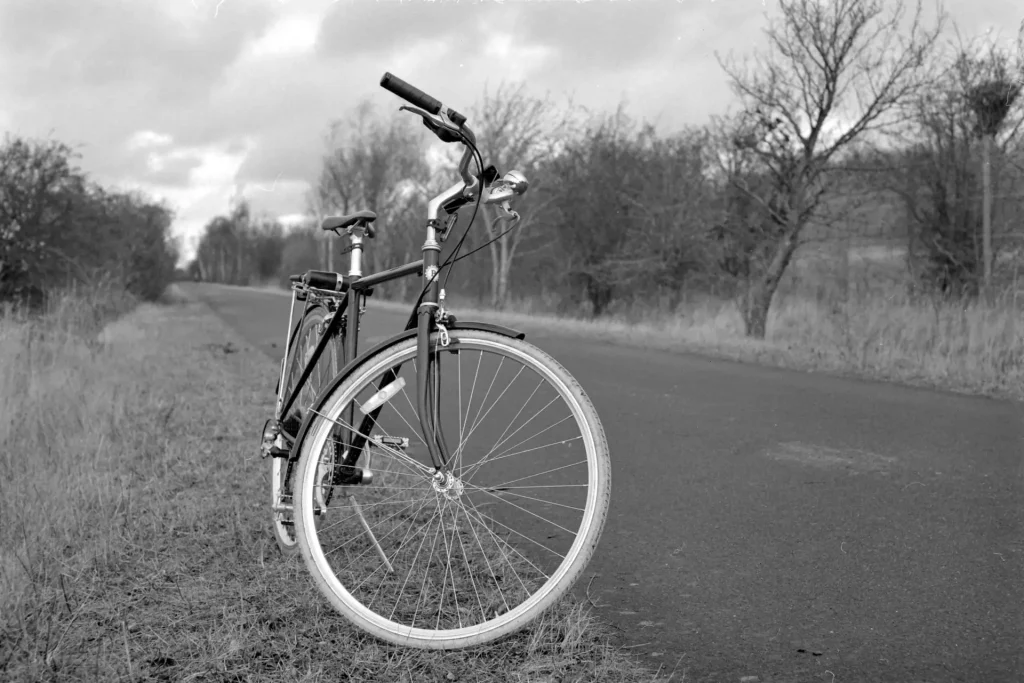
I took the previous photo on the road leading to and running through the marshes. This is flat, low-lying terrain – reclaimed sea bed (though I object to the word “reclaimed”, as if it was ours to begin with). My bike tires are still relatively clean; we haven’t got to the marshes yet.
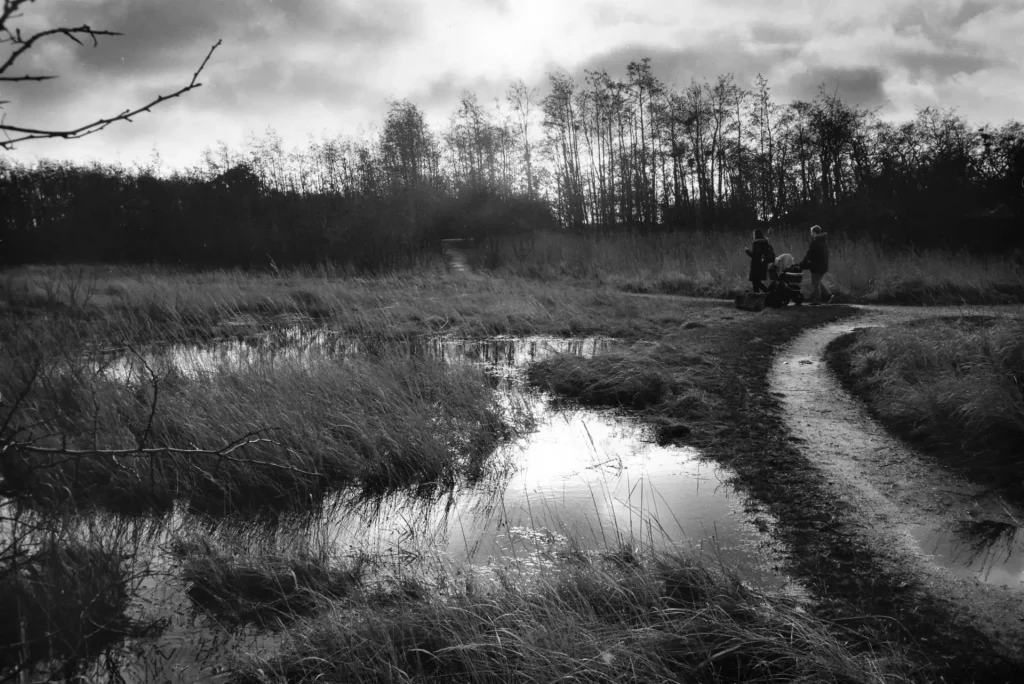
…But now we have. The photo above was with the 28mm at hyperfocal distance. With wide-angle lenses, there’s always a risk of yawning dead space in the foreground which can make for boring compositions. I try to counter this either by getting low to the ground, or by having foreground elements of interest – in this case, the pool of water and the leading line of the path.
The photos in this post were all shot on Fuji Acros 100 at box speed, developed in Ilford ID-11 1+1. Before we move on, let’s take a moment to appreciate the dynamic range of this film. In the last photo, I was shooting straight into the sun, but there is plentiful detail in both clouds and grass. I mostly use Ilford FP4+ or HP5+, and don’t get me wrong: I really like them both. But occasionally I’ll treat myself to a roll of the more expensive Acros, and this is why.
The next photo was also with the 28mm – a reconstructed Viking ship, seemingly stranded in surreal surroundings, with a modern housing development in the distance. A reminder, perhaps, that the land we are standing on was “reclaimed” from the sea, and will one day be reclaimed by it.
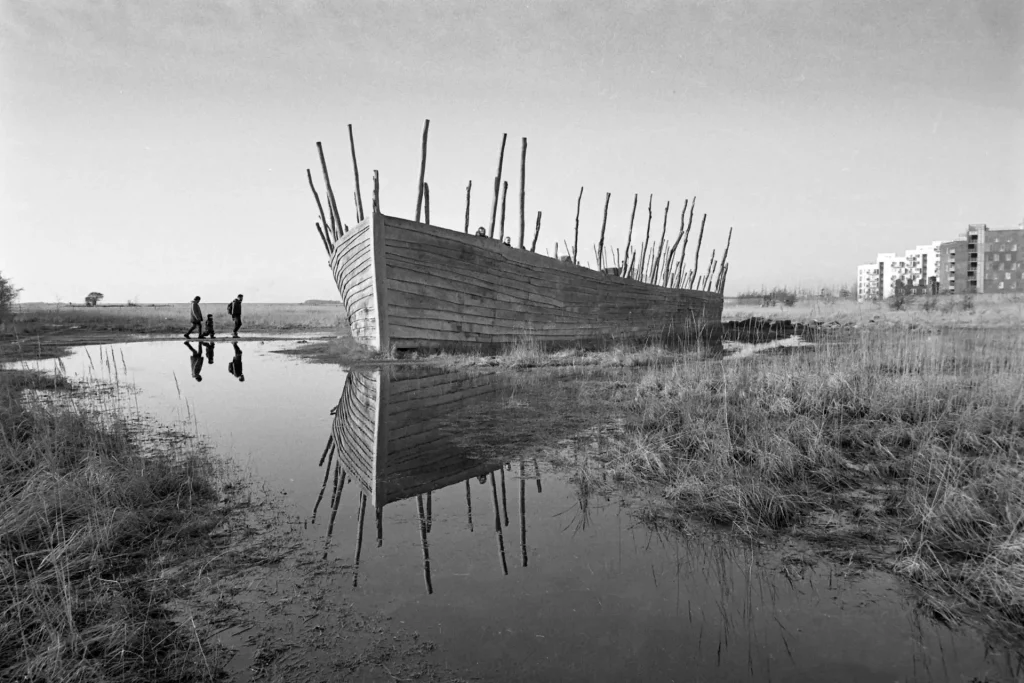
I take landscape photos from time to time, but at heart I think I am a people photographer. As you can see from the last two photos, even my landscape photos often have people in them.
But then we enter the woods, and there are no people. The next two photos were with the 50mm – the left one at f/2, and the right one at f/5.6 (with a slower shutter speed to compensate).
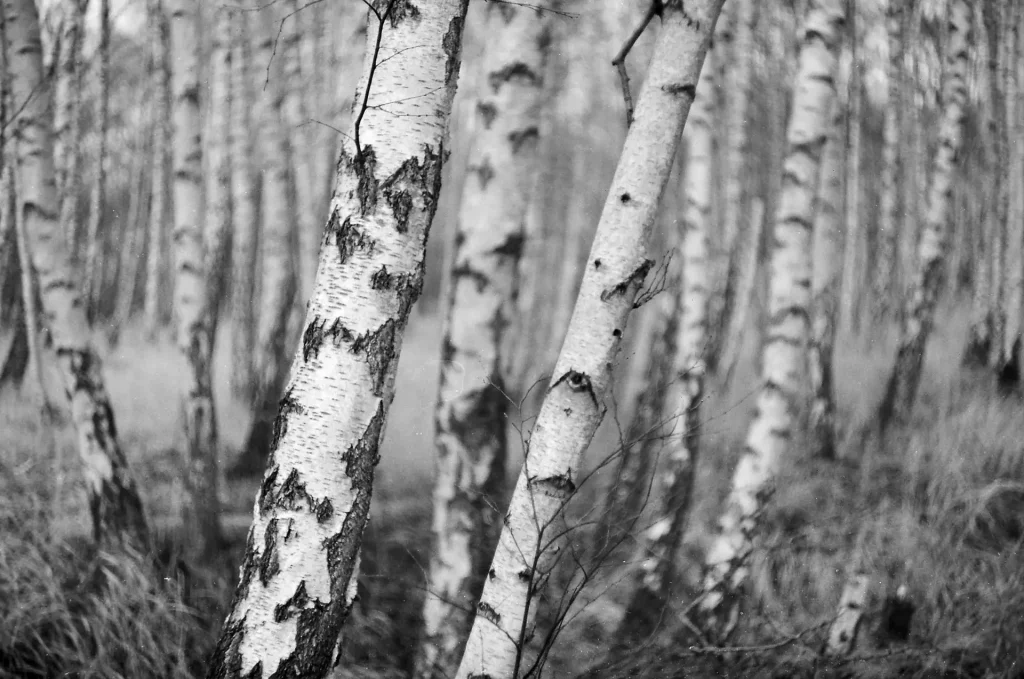
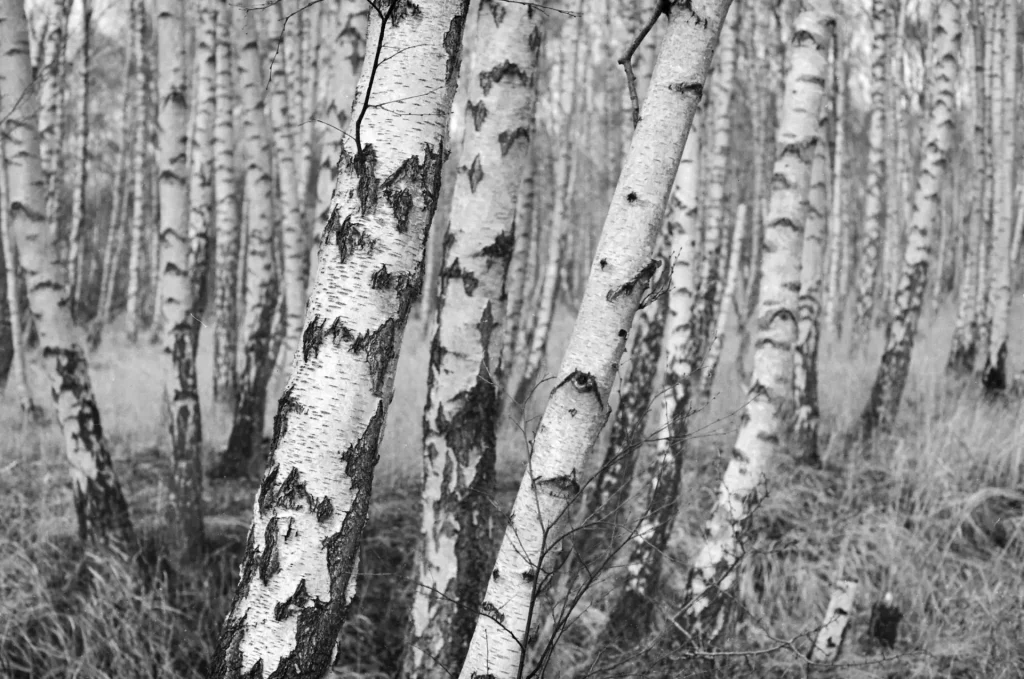
Now I don’t like to go on about bokeh, but I do love how the 64-year-old Summicron lens renders the out-of-focus areas of an image. Moreover, if you observe the markings on the nearest tree, which is what I focused on, you can see how the lens is just slightly soft – some would say “glowy” – at f/2, which can be great for portraits, but almost clinically sharp at f/5.6. It is like having two lenses in one.
By now my bike is giving me an “I didn’t sign up for this” look. It’s a commuter bike – just because I can use it for off-road biking doesn’t mean I should. The 50mm is still in its element, though.
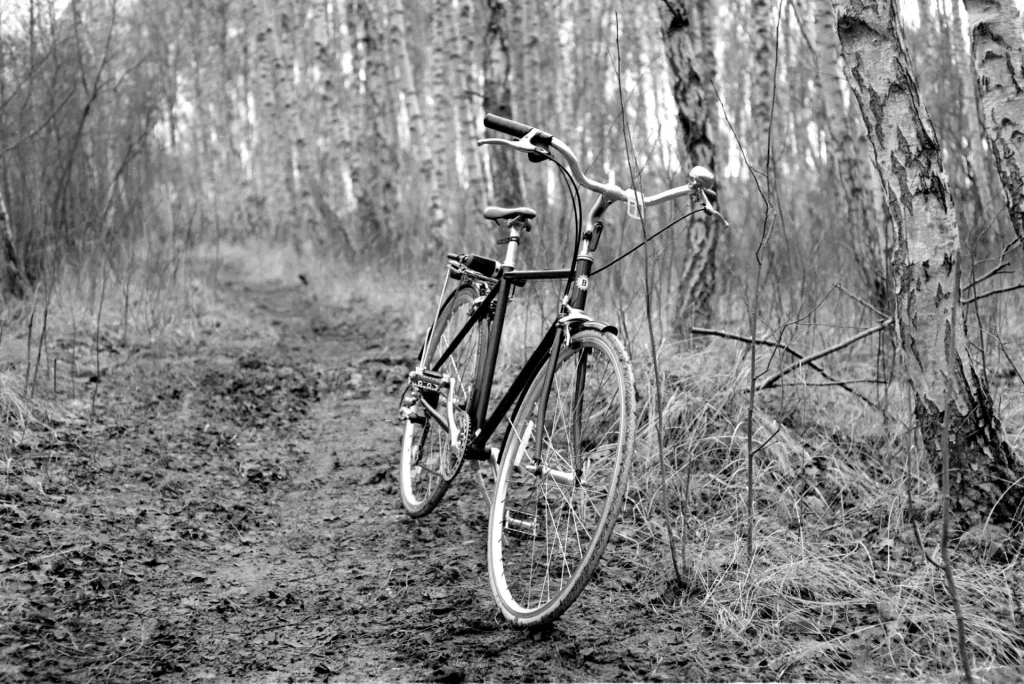
This, by the way, is the same wood where the body was found in The Killing, the Scandi-noir show I mentioned earlier. I didn’t actually know that fact when I took the photo, but I do remember thinking this would be a great place to dispose of a body.
So far I hadn’t used my 135mm lens at all, but on my way back, I spotted a horse in the distance, its mane blowing in the breeze. With the tele lens, I was able to take a snapshot from the side of the road. An f/4 lens is clearly not fast by modern standards, but the long focal length means I can still achieve a fair bit of background separation.
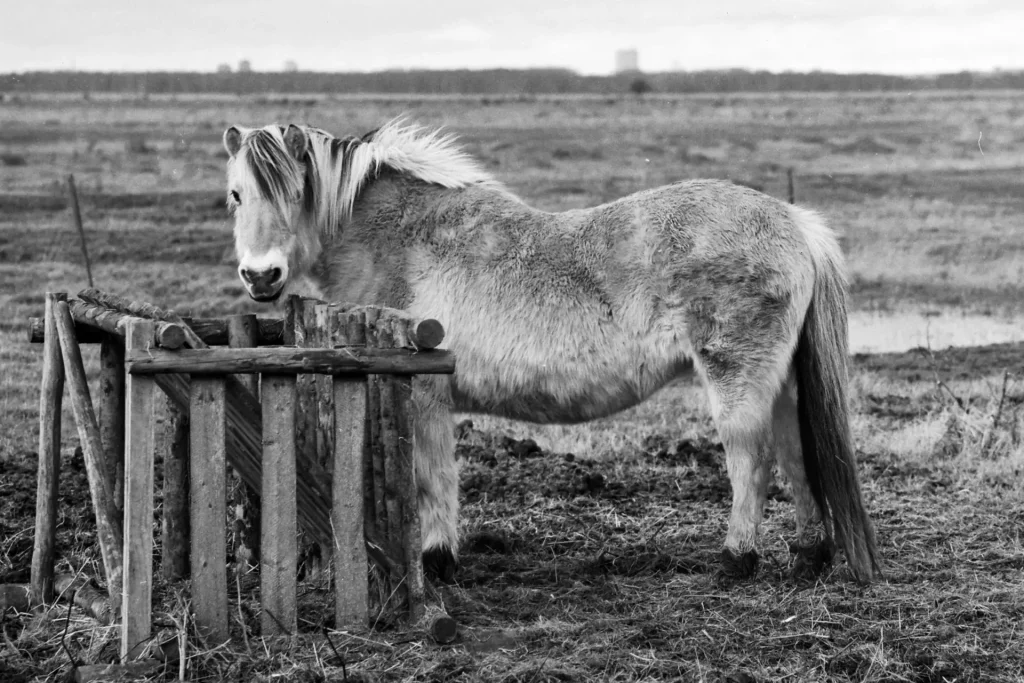
Then I spotted some more horses, and went to take a closer look. There was a woman working on a tractor who kindly gave me permission to take some photos. She turned out to be a member of Foreningen Fælledhestene, a co-operative which keeps horses on the common. These are “barefoot” (unshod) horses which graze freely on the land and help maintain biodiversity. The co-operative itself is non-profit and largely run by volunteers.
Since I was closer, I switched to the 50mm. I did say it is good for portraits!
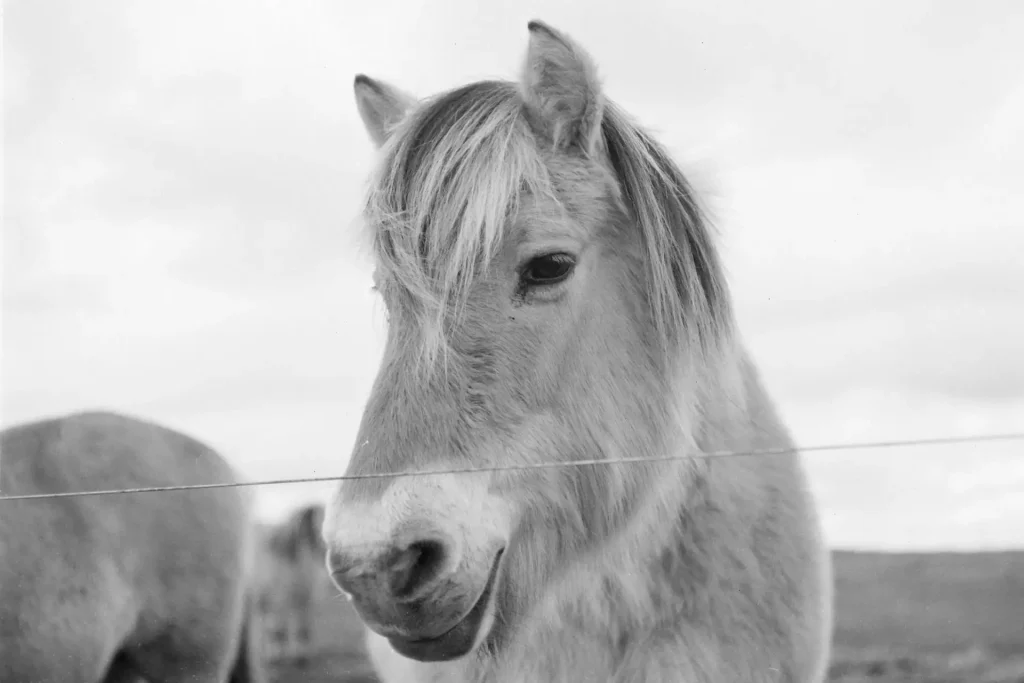
And then, finally, the 28mm, coupled with a low angle to frame the horses against the sky.

So that’s all three lenses, used in a space of about 5 minutes, for three very different equine portraits. Of course, if I wanted to do a proper focal length comparison, I should have shot the same scene from the same angle and kept the framing consistent. But you can already see such comparisons elsewhere (though I would add that it’s the changing subject-distance and perspective that impact the result in that post, not directly the lens – but it’s a nice comparison nonetheless). And besides, what I described above is much closer to how I use lenses in the “real world”. I think about what I want to do, and then try and pick the right tool for the task. Sometimes it works, sometimes it doesn’t. But that’s my fault, not the lenses’.
Thanks for joining me on my marshland bike tour, and I hope you enjoyed the photos! And now it’s time for…
The big reveal

Photo 1 from the Twitter post was with a Leitz Summicron 50mm f/2 (v1 collapsible). Photo 2 was with a Voigtländer Ultron 28mm f/1.9. Photo 3 was with a Leitz Tele-Elmar 135mm f/4.
Just for fun, I tabulated the Twitter guesses this morning. Guess what – for all three photos, the most popular guess was the correct one. A nice demonstration of the Galton’s Ox principle; the collective wisdom of the 35mmc crowd.
| Pic 1 | Pic 2 | Pic 3 | |
| 24mm | – | 13 | – |
| 28mm | – | 17 | – |
| 35mm | 8 | 8 | 3 |
| 50mm | 21 | 2 | 6 |
| 75mm | 7 | 1 | 2 |
| 90mm | 4 | – | 14 |
| 135mm | 1 | – | 16 |
The contest winner – the first to guess all three focal lengths correctly – is @redrichie – enjoy your Analogue Wonderland voucher. Thanks to all who took part in the guessing game, and thanks Hamish and AW for running it!
Share this post:









Comments
Charles Morgan on 3 Focal Lengths in Danish Marshland – by Sroyon Mukherjee
Comment posted: 16/06/2020
Comment posted: 16/06/2020
Chris Pattison on 3 Focal Lengths in Danish Marshland – by Sroyon Mukherjee
Comment posted: 17/06/2020
Comment posted: 17/06/2020
Comment posted: 17/06/2020
bp_reid on 3 Focal Lengths in Danish Marshland – by Sroyon Mukherjee
Comment posted: 17/06/2020
Comment posted: 17/06/2020
Andrew L on 3 Focal Lengths in Danish Marshland – by Sroyon Mukherjee
Comment posted: 17/06/2020
Comment posted: 17/06/2020
Noel on 3 Focal Lengths in Danish Marshland – by Sroyon Mukherjee
Comment posted: 17/06/2020
Comment posted: 17/06/2020
Monkeying Around with Focal Length and Perspective – by Sroyon Mukherjee - 35mmc on 3 Focal Lengths in Danish Marshland – by Sroyon Mukherjee
Comment posted: 24/08/2020